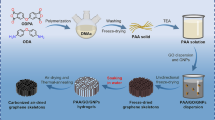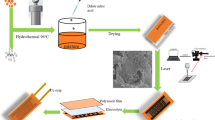Abstract
Aiming to produce electrically conductive polylactic acid (PLA), a reduced graphene oxide (rGO) with low oxygen content was prepared to produce PLA/rGO nanocomposites by melt compounding. The electrical conductivity of PLA/rGO composites improved significantly with the incorporation of rGO at a moderate filler loading, thanks to the large lateral size, low thickness, and low oxygen content of the rGO prepared. Filament for fused-deposition modeling has been produced based on the composite produced at 2% in weight with the purpose of producing devices for electronic applications. An all-polymer humidity sensor device has been prepared using the PLA/rGO filament produced demonstrating the ability to produce all-polymer devices.








Similar content being viewed by others
References
Murariu M, Dubois P (2016) PLA composites: from production to properties. Adv Drug Deliv Rev 107:17–46
Elsawy MA, Kim KH, Park JW, Deep A (2017) Hydrolytic degradation of polylactic acid (PLA) and its composites. Renew Sustain Energy Rev 79:1346–1352
Sadasivuni KK, Ponnamma D, Thomas S, Grohens Y (2014) Evolution from graphite to graphene elastomer composites. Prog Polym Sci 39(4):749–780
Ho PKH, Thomas DS, Friend RH, Tessler N (1999) All-polymer optoelectronic devices. Science 285:233–236
Argun AA, Cirpan A, Reynolds JR (2003) The first truly all-polymer electrochromic devices. Adv Mater 15:1338–1341
Garnier F, Hajlaoui R, Yassar A, Srivastava P (1994) All-polymer field-effect transistor realized by printing techniques. Science 265(5179):1684–1686
Gofer Y, Sarker H, Killian JG, Poehler TO, Searson PC (1997) An all-polymer charge storage device. Appl. Phys. Lett. 71(11):1582–1584
Kim H, Miura Y, Macosko CW (2010) Graphene/polyurethane nanocomposites for improved gas barrier and electrical conductivity. Chem Mater 22(11):3441–3450
Verma M, Chauhan SS, Dhawan SK, Choudhary V (2017) Graphene nanoplatelets/carbon nanotubes/polyurethane composites as efficient shield against electromagnetic polluting radiations. Compos B Eng 120:118–127
Norazlina H, Kamal Y (2015) Graphene modifications in polylactic acid nanocomposites: a review. Polym. Bull. 72(4):931–961
Shen Y et al (2012) Chemical and thermal reduction of graphene oxide and its electrically conductive polylactic acid nanocomposites. Compos Sci Technol 72(12):1430–1435
Gao Y, Picot OT, Bilotti E, Peijs T (2017) Influence of filler size on the properties of poly(lactic acid) (PLA)/graphene nanoplatelet (GNP) nanocomposites. Eur Polym J 86:117–131
Lei L, Qiu J, Sakai E (2012) Preparing conductive poly(lactic acid) (PLA) with poly(methyl methacrylate) (PMMA) functionalized graphene (PFG) by admicellar polymerization. Chem Eng J 209:20–27
Cai C, Liu L, Fu Y (2019) Processable conductive and mechanically reinforced polylactide/graphene bionanocomposites through interfacial compatibilizer. Polym Compos 40(1):389–400
Singh S, Ramakrishna S, Berto F (2019) 3D printing of polymer composites: a short review. Mater Des Process Commun. https://doi.org/10.1002/mdp2.97
Ivanova O, Williams C, Campbell T (2013) Additive manufacturing (AM) and nanotechnology: promises and challenges. Rapid Prototype J 19(5):353–364
Zhang D et al (2016) Fabrication of highly conductive graphene flexible circuits by 3D printing. Synth Met 217:79–86
Farahani RD, Dubé M, Therriault D (2016) Three-dimensional printing of multifunctional nanocomposites: manufacturing techniques and applications. Adv. Mater. 28:5794–5821
Utela B, Storti D, Anderson R, Ganter M (2008) A review of process development steps for new material systems in three dimensional printing (3DP). J Manuf Process 10(2):96–104
Gnanasekaran K et al (2017) 3D printing of CNT- and graphene-based conductive polymer nanocomposites by fused deposition modeling. Appl Mater Today 9:21–28
Lamberti P et al (2018) Evaluation of thermal and electrical conductivity of carbon-based PLA nanocomposites for 3D printing. AIP Conf Proc 1981:3–7
Wei X et al (2015) 3D printable graphene composite. Sci Rep 5:11181. https://doi.org/10.1038/srep11181
Fu S, Sun Z, Huang P, Li Y, Hu N (2019) Some basic aspects of polymer nanocomposites: a critical review. Nano Mater Sci 1(1):2–30
Galindo B, Alcolea SG, Gómez J, Navas A, Murguialday AO, Fernandez MP, Puelles RC (2014) Effect of the number of layers of graphene on the electrical properties of TPU polymers. IOP Conf Ser Mater Sci Eng 64:12008. https://doi.org/10.1088/1757-899X/64/1/012008
Eigler S, Grimm S, Enzelberger-Heim M, Müller P, Hirsch A (2013) Graphene oxide: efficiency of reducing agents. Chem Commun 49(67):7391
Dreyer DR, Park S, Bielawski CW, Ruoff RS (2010) The chemistry of graphene oxide. Chem Soc Rev 39(1):228–240
Hummers WS, Offeman RE (1958) Preparation of graphitic oxide. J Am Chem Soc 80(6):1339
Gómez J, Villaro E, Navas A, Recio I (2017) Testing the influence of the temperature, RH and filler type and content on the universal power law for new reduced graphene oxide TPU composites. Mater Res Express 4(10):105020
Gomez J, Recio I, Navas A, Villaro E, Galindo B, Ortega Murguialday A (2019) Processing influence on dielectric, mechanical and electrical properties of reduced graphene oxide-TPU nanocomposites. J. Appl. Polym. Sci. 136:47220
Chee SY, Poh HL, Chua CK, Sanek F, Sofer Z, Pumera M (2012) Influence of parent graphite particle size on the electrochemistry of thermally reduced graphene oxide. Phys Chem Chem Phys 14(37):12794–12799
Pan S, Aksay IA (2011) Factors controlling the size of graphene oxide sheets produced via the graphite oxide route. ACS Nano 5(5):4073–4083
Ambrosetti G, Grimaldi C, Balberg I, Maeder T, Danani A, Ryser P (2010) Solution of the tunneling-percolation problem in the nanocomposite regime. Phys Rev B Condens Matter Mater Phys 81(15):1–12
Zhang R, Zhang B, Sun S (2015) Preparation of high-quality graphene with a large-size by sonication-free liquid-phase exfoliation of graphite with a new mechanism. RSC Adv 5(56):44783–44791
JabariSeresht R, Jahanshahi M, Rashidi A, Ghoreyshi AA (2013) Synthesize and characterization of graphene nanosheets with high surface area and nano-porous structure. Appl Surf Sci 276:672–681
Cui P, Lee J, Hwang E, Lee H (2011) One-pot reduction of graphene oxide at subzero temperatures. Chem Commun 47(45):12370–12372
Joya MR, Gonzalez JD, Barba-Ortega J (2014) Raman spectroscopy as a versatile tool for studying of explicit contribution of anharmonicity. J Nonlinear Opt Phys Mater 23(4):235
King AAK et al (2016) A new raman metric for the characterisation of graphene oxide and its derivatives. Sci Rep 6:1–6
Bokobza L (2017) Spectroscopic techniques for the characterization of polymer nanocomposites: a review. Polymers (Basel) 10(1):7
Kister G, Cassanas G, Vert M, Pauvert B, Tbol A (1995) Vibrational analysis of poly(L-lactic acid). J Raman Spectrosc 26:307–311
Casiraghi C, Pisana S, Novoselov KS, Geim AK, Ferrari AC (2007) Raman fingerprint of charged impurities in graphene. Appl Phys Lett 91:233108. https://doi.org/10.1063/1.2818692
Tong XZ, Song F, Li MQ, Wang XL, Chin IJ, Wang YZ (2013) Fabrication of graphene/polylactide nanocomposites with improved properties. Compos Sci Technol 88:33–38
Yang JH, Lin SH, Der Lee Y (2012) Preparation and characterization of poly(l-lactide)-graphene composites using the in situ ring-opening polymerization of PLLA with graphene as the initiator. J Mater Chem 22(21):10805–10815
Sabzi M, Jiang L, Liu F, Ghasemi I, Atai M (2013) Graphene nanoplatelets as poly(lactic acid) modifier: linear rheological behavior and electrical conductivity. J Mater Chem A 1(28):8253–8261
Ivanov E et al (2019) PLA/graphene/MWCNT composites with improved electrical and thermal properties suitable for FDM 3D printing applications. Appl Sci 9(6):1209
Author information
Authors and Affiliations
Contributions
EV was preparing and characterizing PLA-rGO composites and originally writing the paper. JP is responsible for device preparation and characterization. JG is responsible for the conceptualization, supervision, methodology and reviewing the article. BAH project management, reviewing, and proofreading the paper.
Corresponding author
Ethics declarations
Conflict of interest
The authors declare that they have no conflict of interest.
Additional information
Publisher's Note
Springer Nature remains neutral with regard to jurisdictional claims in published maps and institutional affiliations.
Rights and permissions
About this article
Cite this article
Gomez, J., Villaro, E., Perez, J. et al. Preparation of electrically conductive PLA/rGO nanocomposite filaments. Graphene Technol 5, 41–48 (2020). https://doi.org/10.1007/s41127-020-00031-3
Received:
Revised:
Accepted:
Published:
Issue Date:
DOI: https://doi.org/10.1007/s41127-020-00031-3




